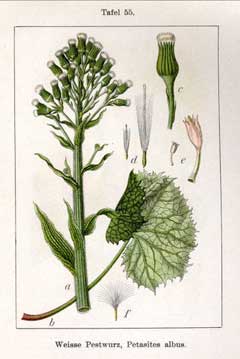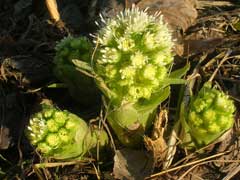 |
|
http://commons.wikimedia.org/wiki/File:Petasites_albus_Sturm55.jpg |
 |
| http://commons.wikimedia.org/wiki/User:Anna_reg |
Translate this page:
Summary
Physical Characteristics

 Petasites albus is a PERENNIAL growing to 0.6 m (2ft) by 1 m (3ft 3in) at a fast rate.
Petasites albus is a PERENNIAL growing to 0.6 m (2ft) by 1 m (3ft 3in) at a fast rate.
See above for USDA hardiness. It is hardy to UK zone 5. It is in flower from April to May, and the seeds ripen in May. The species is dioecious (individual flowers are either male or female, but only one sex is to be found on any one plant so both male and female plants must be grown if seed is required). and is pollinated by Insects. The plant is not self-fertile.
Suitable for: light (sandy), medium (loamy) and heavy (clay) soils and can grow in heavy clay soil. Suitable pH: mildly acid, neutral and basic (mildly alkaline) soils. It can grow in full shade (deep woodland) semi-shade (light woodland) or no shade. It prefers moist soil.
UK Hardiness Map
US Hardiness Map
Synonyms
Tussilago alba.
Plant Habitats
Woodland Garden Dappled Shade; Shady Edge; not Deep Shade; Ground Cover; Meadow;
Edible Uses
Edible Parts: Stem
Edible Uses:
The small fleshy petioles (leaf stems) are very palatable when cooked and eaten like asparagus[7].
References More on Edible Uses
Medicinal Uses
Plants For A Future can not take any responsibility for any adverse effects from the use of plants. Always seek advice from a professional before using a plant medicinally.
Antitussive Emmenagogue Homeopathy Hypnotic Sedative Vulnerary
The root is emmenagogue, hypnotic, sedative and vulnerary[7, 172]. The ground or finely chopped rhizome has a healing effect when applied to slow-healing or weak ulcers, or to suppurating wounds[7]. An infusion of the leaves is a specific remedy for coughs[7]. A homeopathic remedy is made from the roots[7]. It is used in the treatment of wounds, ulcers etc[7].
References More on Medicinal Uses
The Bookshop: Edible Plant Books
Our Latest books on Perennial Plants For Food Forests and Permaculture Gardens in paperback or digital formats.

Edible Tropical Plants
Food Forest Plants for Hotter Conditions: 250+ Plants For Tropical Food Forests & Permaculture Gardens.
More

Edible Temperate Plants
Plants for Your Food Forest: 500 Plants for Temperate Food Forests & Permaculture Gardens.
More

More Books
PFAF have eight books available in paperback and digital formats. Browse the shop for more information.
Shop Now
Other Uses
A good ground cover for the wilder areas of the garden[200]. It is too invasive to be used in small gardens and is only suitable for covering large areas[208]. The leaves were at one time used by peasants as a head covering[7].
Special Uses
Ground cover
References More on Other Uses
Cultivation details
Succeeds in ordinary garden soil[1], but prefers a deep fertile humus-rich soil that is permanently moist but not stagnant, succeeding in shade, semi-shade or full sun[200]. Prefers partial shade[31]. Prefers a heavy soil[208]. Plants can be grown in quite coarse grass, which can be cut annually in the autumn[233]. A very invasive plant, too rampant for anything other than the wild garden[187, 200]. Dioecious, male and female plants must be grown if seed is required.
References Carbon Farming Information and Carbon Sequestration Information
Temperature Converter
Type a value in the Celsius field to convert the value to Fahrenheit:
Fahrenheit:
The PFAF Bookshop
Plants For A Future have a number of books available in paperback and digital form. Book titles include Edible Plants, Edible Perennials, Edible Trees,Edible Shrubs, Woodland Gardening, and Temperate Food Forest Plants. Our new book is Food Forest Plants For Hotter Conditions (Tropical and Sub-Tropical).
Shop Now
Plant Propagation
Seed - we have no information on this species but suggest sowing the seed in a cold frame as soon as it is ripe or in early spring. Only just cover the seed and do not allow the compost to dry out. When they are large enough to handle, prick the seedlings out into individual pots and plant them out in the summer. Division succeeds at almost any time of the year. Very easy, larger divisions can be planted out direct into their permanent positions. We have found that it is better to pot up the smaller divisions and grow them on in light shade in a cold frame until they are well established before planting them out in late spring or early summer.
Other Names
If available other names are mentioned here
Native Range
Coming Soon
Weed Potential
Right plant wrong place. We are currently updating this section.
Please note that a plant may be invasive in one area but may not in your area so it's worth checking.
Conservation Status
IUCN Red List of Threatened Plants Status :

| Related Plants
|
| Latin Name | Common Name | Habit | Height | Hardiness | Growth | Soil | Shade | Moisture | Edible | Medicinal | Other |
| Petasites frigidus | Sweet Coltsfoot, Arctic sweet coltsfoot, Arrowleaf sweet coltsfoot, Golden Palms Coltsfoot, Butterb | Perennial | 0.2 |
6-10
| F | LMH | FSN | MWe | 2 | 1 | 2 |
| Petasites hybridus | Butterbur, Pestilence wort | Perennial | 1.0 |
4-8
| F | LMH | FSN | MWe | 0 | 3 | 0 |
| Petasites hyperboreus | Arctic Sweet Coltsfoot | Perennial | 0.2 |
4-8
| F | LMH | FSN | MWe | 2 | 1 | 2 |
| Petasites japonicus | Sweet Coltsfoot, Japanese sweet coltsfoot, Butterbur | Perennial | 0.6 |
5-9
| F | LMH | FSN | MWe | 3 | 2 | 1 |
| Petasites palmatus | Sweet Butterbur, Golden Palms Coltsfoot, Sweet Coltsfoot, Butterbur | Perennial | 0.4 |
6-10
| F | LMH | FSN | MWe | 2 | 1 | |
| Petasites saggitatus | Arrowleaf Sweet Coltsfoot | Perennial | 0.2 |
-
| F | LMH | FSN | MWe | 2 | 1 | |
| Petasites speciosa | | Perennial | 0.0 |
-
| F | LMH | FSN | MWe | 2 | 0 | |
| Petasites vitifolius | Arctic sweet coltsfoot | Perennial | 0.6 |
0-0
| F | LMH | FSN | MWe | 1 | 0 | |
|
Growth: S = slow M = medium F = fast. Soil: L = light (sandy) M = medium H = heavy (clay). pH: A = acid N = neutral B = basic (alkaline). Shade: F = full shade S = semi-shade N = no shade. Moisture: D = dry M = Moist We = wet Wa = water.
Now available:
Food Forest Plants for Mediterranean Conditions
350+ Perennial Plants For Mediterranean and Drier Food Forests and Permaculture Gardens.
[Paperback and eBook]
This is the third in Plants For A Future's series of plant guides for food forests tailored to
specific climate zones. Following volumes on temperate and tropical ecosystems, this book focuses
on species suited to Mediterranean conditions—regions with hot, dry summers and cool, wet winters,
often facing the added challenge of climate change.
Read More
Expert comment
Author
(L.)Gaertn.
Botanical References
17200
Links / References
For a list of references used on this page please go here
Readers comment
| Add a comment |
|
If you have important information about this plant that may help other users please add a comment or link below. Only comments or links that are felt to be directly relevant to a plant will be included. If you think a comment/link or information contained on this page is inaccurate or misleading we would welcome your feedback at [email protected]. If you have questions about a plant please use the Forum on this website as we do not have the resources to answer questions ourselves.
* Please note: the comments by website users are not necessarily those held by PFAF and may give misleading or inaccurate information.
To leave a comment please Register or login here All comments need to be approved so will not appear immediately.
|
Subject : Petasites albus
|
|
|
|